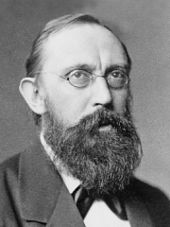Plankton expedition
The plankton expedition in 1889 was a German oceanographic research trip with the steamer National and the first worldwide to focus on plankton . It served the goal of recording the distribution of plankton in the Atlantic both qualitatively and quantitatively.
The leader of the expedition was the chairman of the Prussian Marine Commission, the Kiel marine biologist Victor Hensen . In 1887 he introduced the term “plankton”.
financing
Hensen managed to raise the considerable sum of 105,600 marks for the expedition. The Prussian Academy of Sciences contributed 24,600 marks from the funds of the Alexander von Humboldt Foundation . 70,000 marks came from the imperial disposition fund, another 10,000 marks were donated by the section for coastal and deep-sea fishing of the German Fisheries Association , and an amount of 1,000 marks had been donated from an unknown private source to take along a marine painter . The real cost of the expedition ended up being 70,000 marks.
Attendees
- Victor Hensen, physiologist
- Karl Brandt , zoologist
- Franz Schütt (1859–1921), botanist
- Friedrich Dahl , zoologist
- Otto Krümmel , geographer
- Richard Eschke , marine painter
- Bernhard Fischer , physician and marine microbiologist
course
The ship left Kiel on July 15, 1889 and passed the Orkney Islands on July 19. Following the 60th parallel, it reached the southern tip of Greenland on July 26th , where it continued its journey towards Newfoundland , which was passed on July 31st. From there, the steamer reached the Bermuda Islands and from August 10th followed the 31st parallel through the Sargasso Sea to the east. When the 40th degree of longitude was reached, the course was set for the Cape Verde Islands , cutting the north equatorial current . On August 28, the expedition was at São Vicente , crossed the Guinea Current and on September 7, passed the equator at 15 ° west longitude. Continuing south, the southernmost point at Ascension Island was reached on September 12th . The ship then crossed the Atlantic through the south equatorial current to the west and reached the mouth of the Amazon on September 23, passing the Brazilian island group Fernando de Noronha . When attempting to enter the Amazon, the ship ran onto a sandbank and the propeller was damaged. After completing the necessary repair work, the expedition set out on the journey home on October 8th. Due to renewed problems with the propulsion, the ship had to call at the port of Ponta Delgada on the Azores island of São Miguel on October 22nd . The trip could not continue until October 27th. On November 7th, the expedition returned to Kiel after having covered 15,649 nautical miles .
Scientific work and results
As with previous oceanographic expeditions, a large part of the scientific work has been to capture and describe marine organisms. For this purpose, 110 catches were carried out near the water surface with horizontal nets. Catches from depths of up to 3500 meters could be brought in with 33 locking net trains. By focusing on the plankton, the expedition complemented itself well with the British Challenger Expedition from 1872 to 1876, which mainly dealt with the creatures of the deep sea .
Hensen's scientific approach to plankton research differed from that of previous oceanographic expeditions in that he sought to arrive at an accurate quantitative description. Samples of the plankton were taken at 126 places in the Atlantic with very fine-meshed silk nets developed in-house, which were intended to hold back even the smallest planktonic organisms, by filtering it out completely from a water column 200 meters deep down to the surface of the water. The mass and volume of the catch were then measured and the number of organisms of each species contained was counted. With the help of statistical methods, first estimates of the amount and composition of the plankton of the entire Atlantic Ocean could be made. A finding that came as a surprise to the experts at the time was that the cold arctic parts of the ocean proved to be significantly more productive in plankton production than the warm tropical ones . Hensen explained this by a lack of food in the tropical offshore waters.
The geodetic, meteorological and geophysical work carried out by Otto Krümmel was somewhat overshadowed by the marine biological investigations. For example, the depth of the sea was determined several times with a plumb machine to Sigsbee . Krümmel also made regular weather observations (temperature, air pressure, humidity, wind speed, cloud shape). In addition, he recorded vertical temperature profiles of the sea and determined the color of the water by comparison with a standardized color scale . He attached particular importance to measuring the salinity of sea water. In addition to chemical analysis (chlorine titration), he carried out density measurements with hydrometers . In addition, he experimented with an Abbe refractometer supplied by Carl Zeiss , with which the salt content could be determined using the refractive index .
The processing of the extensive collected material by twenty-three scientists took several years and was published in five volumes from a total of 52 deliveries.
literature
- Victor Hensen (Hrsg.): Results of the plankton expedition of the Humboldt Foundation , 5 volumes (52 deliveries), Lipsius and Tischer, Kiel and Leipzig 1892–1912
Individual evidence
- ↑ Karl Brandt: About the biological investigations of the plankton expedition . In: Naturwissenschaftliche Rundschau 5, 1890, pp. 112–114
- ^ Victor Hensen: Some results of the plankton expedition of the Humboldt Foundation . In: Naturwissenschaftliche Rundschau 5, 1890, pp. 318-320
Web links
- The plankton expedition on the website of the Berlin-Brandenburg Academy of Sciences
- Meyers Konversationslexikon, 4th edition, 19th volume, 1891–1892 in the retro library
- Plankton expedition . In: Meyers Großes Konversations-Lexikon . 6th edition. Volume 16, Bibliographisches Institut, Leipzig / Vienna 1908, p. 11 .



